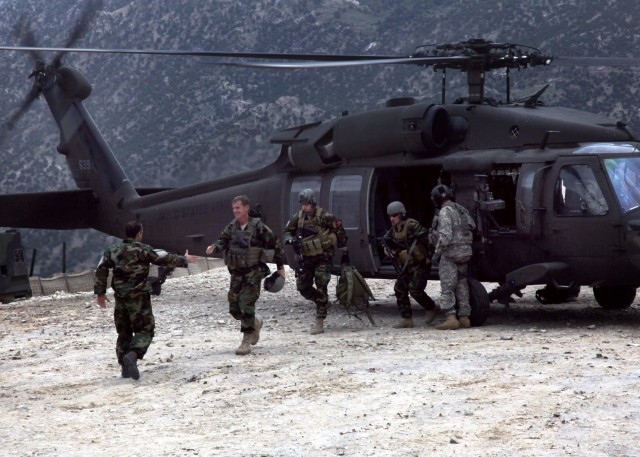BAGRAM AIRFIELD, Afghanistan - The sound of rotor blades broke the silence of night as air crews descended on a combat outpost blanketed in darkness. Staring through their night vision goggles crew chiefs guided Chinooks to their landing zones, ready to receive Soldiers and equipment as U.S. forces pulled out of the Korengal Valley of Afghanistan.
"Task Force Mountain Warrior had multiple bases in areas in the Korengal Valley where villages were sporadic and the population uncondensed," said Maj. Mike Reyburn, plans officer for the 3rd Combat Aviation Brigade (Marne Air), TF Falcon. "Task Force Falcon worked in support of (Regional Command East) in relocating TF Mountain Warrior Soldiers as part of efforts to focus on areas of higher Afghan populace. We assisted by being the main transport element, moving equipment and personnel out of the various COPs swiftly and safely from the so-called 'valley of death.'"
The terrain conditions of the Korengal Valley are so treacherous that many of the locations can only be reached by air making TF Falcon's aviation assets essential to the success of relocating personnel and equipment.
The operation, called Operation Mountain Descent II, resulted in moving more than 500 Soldiers and nearly half a million pounds of equipment. Task Force Lighthorse, a battalion-sized element within TF Falcon, led the charge and successfully completed 76 flights to support the operation without incident.
"Based on the intensity of the fighting and the loss of life associated with two previous retrograde operations at COP Bella and COP Keating, we suspected that we would be in for a tough fight," said Lt. Col. Thomas von Eschenbach, commander of TF Lighthorse. "Taking every measure possible our planners dedicated an enormous amount of time and work in planning and synchronizing an incredible array of assets to support the conduct of Operation Mountain Descent. Flying helicopters around the clock TF Lighthorse executed flawless aviation operations over a four-day period, ending with a single Chinook departing with the last load of Soldiers at 3 a.m., April 14."
The Korengal valley is six miles long with one way in and one way out and the enemy owns the high ground, said Col. Don Galli, commander of TF Falcon. The valley maintains a reputation of being one of the most dangerous locations in Afghanistan, and for aviators the conditions were made more perilous due to what is called, "red illum" conditions.
Red illum conditions occur when illumination is less than 25 percent. For aviators who operate with night vision goggles, this poses a problem because NVGs heighten ambient light such as starlight or moonlight enabling them to see. With a lack of light, air crews must strain to see the faint outlines of small landing zones and towering mountains making their missions increasingly hazardous.
"Task Force Mountain Warrior got a lot of well deserved recognition for their tremendous efforts during the retrograde, but our aviators accepted much of the risk and performed as professionals," said Col. Galli. "Not to take anything away from the infantry; they had a tough fight; but the aviators didn't have it easy. This was extremely dangerous and (the aircrews) were incredibly vulnerable to enemy fire."
To deter the enemy from firing, attack and scout teams of Apaches and Kiowa Warriors flew around the clock prepared to defend the air and ground units as they withdrew.
"During the day we worked to deter movement and flooded the valley with attack assets making it incredibly difficult for the enemy to move around and set up for an ambush," said Maj. Daniel Rice, plans officer for TF Knighthawk, another subordinate battalion of TF Falcon. "We denied the enemy freedom of maneuver during the day and guarded our lift assets at night."
Task Force Knighthawk provided "extra muscle" to TF Lighthorse who led the overall missions from Forward Operating Base Jalalabad. Plans were synced each night ensuring the flight crews understood the intent of each mission. In addition to the primary flight roles, Soldiers from both TF Lighthorse and TF Knighthawk served in contingency roles such as the quick reaction force, the downed aircraft recovery team and stood ready in case of a mass casualty situation.
"I was up there every night and saw firsthand what my crews did," said Col. Galli. "Words cannot explain the skill and bravery of our aircrews. They knew the danger, and I have never been more proud in my military career than to see what Lighthorse and Knighthawk did in the Korengal Valley. That's the spirit of Marne Air."




Social Sharing